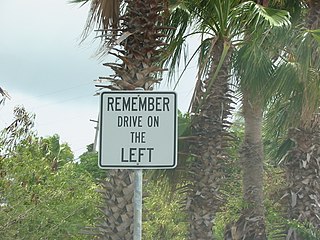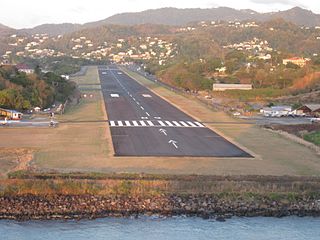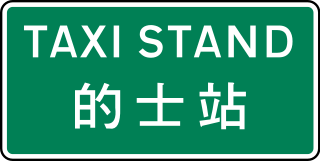Transport in Saint Lucia includes transportation to and from Saint Lucia, which is a sovereign island country located in the eastern Caribbean Sea. It also includes transportation from one part of the island to another.
Transport in Saint Lucia includes transportation to and from Saint Lucia, which is a sovereign island country located in the eastern Caribbean Sea. It also includes transportation from one part of the island to another.
Saint Lucia is served by two airports. Larger jets arrive at Hewanorra International Airport located in Vieux Fort, 40 miles South of Castries (which is the island's capital and largest city). Smaller inter-island planes land at George F.L. Charles Airport, just outside of Castries. Many major airlines serve Saint Lucia. Several smaller airlines fly to George F.L. Charles via neighbouring islands.
Cruise ships enter the main seaport at Castries, and dock at one of the facilities there. Fast and modern catamaran can be booked for travel to and from the islands of Martinique, Guadeloupe, and Dominica. Yachts dock at various facilities in Castries, Marigot Bay, or Rodney Bay.
Saint Lucia's mini buses offer inexpensive transportation and run until approximately 10 pm (longer on Friday nights when the weekly "jump up" takes place at Gros Islet). All buses are registered with a green 'M' licence plate and labelled with a yellow sticker on the front of the vehicle, signifying their route.
Taxis are widely available at the airports and city centers. Fares are not metered, but rather fixed for each destination. Taxi drivers can confirm the cost and currency (EC$ or US$) of the fare before each trip is made. Taxi licence plates are red or blue, and begin with the letters TX.
Truckers are an integral part of the business of shipping especially heavy-duty truckers moving containerised cargo. Over the years this sector of business has grown significantly with a number of major companies competing for the business. Despite this competitive spirit they have been practical and wise enough to see the benefits of forming a Truckers Association, which was established some five years ago but is currently dormant. With the number of issues being faced, members are currently engaged in re-energising the association to interface with the various stakeholders to address a catalogue of observations they want to share with the main shipping actors, including SLASPA and Customs.
Some of the issues being faced are the costs for operating the business are going up - including fuel, tyres, parts, labour, etc.
Among the issues are of concern, some of which require better recognition and involvement from the Transport Board are:
Most transportation in Cape Verde is done by air. There are regular flights between the major islands, with less frequent flights to the other islands. Boat transportation is available, though not widely used nor dependable. In the major cities, public bus transport runs periodically, and taxis are common. In smaller towns, there are mostly hiaces and/or taxis.
All of the major transportation systems in Haiti are located near or run through the capital, Port-au-Prince.

Hong Kong has a highly developed transport network, encompassing both public and private transport. Based on Hong Kong Government's Travel Characteristics Survey, over 90% of daily journeys are on public transport, the highest rate in the world. However, in 2014 the Transport Advisory Committee, which advises the Government on transportation issues, issued a report on the much-worsened congestion problem in Hong Kong and pointed at the excessive growth of private cars during the past 10–15 years.
Transport in Saint Christopher and Nevis includes normal road traffic, public buses, taxis, ferries, airports, and one railway.

Transportation in Singapore is predominantly land-based, with a comprehensive network of roads making many parts of the city-state, including islands such as Sentosa and Jurong Island, accessible. The road network is complemented by a robust rail system consisting of the Mass Rapid Transit (MRT) and the Light Rail Transit (LRT), which cover the length and width of Singapore and serve a few neighbourhoods respectively. The main island of Singapore is also connected to other islands via ferryboat services. Furthermore, the city-state maintains strong international connections through two bridges linking it to Malaysia – the Causeway and the Second Link – and the Singapore Changi Airport, a major aviation hub in Asia.
Different methods of transportation in South Africa include roads, railways, airports, and water. Most people in South Africa use informal minibus taxis as their primary mode of transport. BRT, a bus service, has been implemented in some South African cities to provide more formalised and safer public transport services. These systems have been criticised due to their significant capital and operating costs. South Africa has many major ports, including Cape Town, Durban, and Port Elizabeth.
Trinidad and Tobago, a country that relies heavily on industrialisation and tourism, has various transport systems.
The vast majority of passenger travel in the United States occurs by automobile for shorter distances and airplane or railroad for longer distances. Most cargo in the U.S. is transported by, in descending order, railroad, truck, pipeline, or boat; air shipping is typically used only for perishables and premium express shipments. Transportation is the largest source of greenhouse gas emissions in the United States.

The United States Virgin Islands (USVI) is the only place under United States jurisdiction where the rule of the road is to drive on the left. However, virtually all passenger vehicles are left hand drive due to imports of U.S. vehicles.

Castries is the capital and largest city of Saint Lucia, an island country in the Caribbean. The urban area has a population of approximately 20,000, while the eponymous district has a population of 70,000, as at May 2013. The city covers 80 km2 (31 sq mi).
Antigua and Barbuda's transport systems include both public and privately run services. Roads in the country are paved and follow a winding and gently sloping course connecting parishes to villages and communities. Driving is on the left-hand side. The speed limit is set at 40 mph, Traffic signs posted throughout main roads in Antigua and Barbuda allow for ease of commute, and with GPS coordinates posted throughout the country, the process of navigation has become even easier.

Barbados is a relatively small country with a length of 21 miles (34 km) and a width of 14 miles (23 km). Barbados has 1,600 kilometres (990 mi) of public paved roads, two active marine ports in, remnants of a railway system, and one airport; the Sir Grantley Adams International Airport, located in Christ Church.

Hewanorra International Airport, located near Vieux Fort Quarter, Saint Lucia, in the Caribbean, is the larger of Saint Lucia's two airports and is managed by the Saint Lucia Air and Seaports Authority (SLASPA). It is on the southern cape of the island, about 53.4 km (33.2 mi) from the capital city, Castries.

George F. L. Charles Airport is the smaller of the two airports in Saint Lucia, the other being Hewanorra International Airport. It is located 2 km (1.2 mi) north of Castries, the capital city. George F. L. Charles Airport is managed by the Saint Lucia Air and Seaports Authority (SLASPA). Its runway runs parallel to a pristine beach, Vigie Beach, which is a popular tourist attraction.

Hong Kong taxicabs are the principal taxi service in Hong Kong. Although a few taxis are independently owned and operated, the vast majority are owned by 17 independent taxi companies that rent out taxis on a shift basis to 40,000 self-employed drivers.
Carib Aviation was an airline based in Antigua and Barbuda.

A freight rate is a price at which a certain cargo is delivered from one point to another. The price depends on the form of the cargo, the mode of transport, the weight of the cargo, and the distance to the delivery destination. Many shipping services, especially air carriers, use dimensional weight for calculating the price, which takes into account both weight and volume of the cargo.
A specialized set of jargon describe the tools, equipment, and employment sectors used in the trucking industry in the United States. Some terms may be used within other English-speaking countries, or within the freight industry in general. For example, shore power is a term borrowed from shipping terminology, in which electrical power is transferred from shore to ship, instead of the ship relying upon idling its engines. Drawing power from land lines is more efficient than engine idling and eliminates localized air pollution. Another borrowed term is "landing gear", which refers to the legs which support the front end of a semi-trailer when it is not connected to a semi-truck. Some nicknames are obvious wordplay, such as "portable parking lot", in reference to a truck that carries automobiles.
Taxicabs and other vehicles-for-hire in Canada are regulated by local municipalities and provinces, and are owned & operated by private companies and individuals. Unlicensed cabs in some cities are referred to as bandit taxis/cabs.

The Jacksonville transportation network includes ground, air, and sea options for passenger and freight transit. The Jacksonville Port Authority (Jaxport) operates the Port of Jacksonville, which includes container shipping facilities at Blount Island Marine Terminal, the Talleyrand Marine Terminal and the Dames Point Marine Terminal. Jacksonville Aviation Authority managers Jacksonville International Airport in Northside, as well as several smaller airports. The Jacksonville Transportation Authority (JTA) operates bus, people mover, and park-n-ride services throughout the city and region. A major bus terminal at the intermodal Rosa Parks Transit Station serves as JTA's main transit hub. Various intercity bus companies terminate near Central Station. Amtrak operates passenger rail service to and from major cities throughout North America. The city is bisected by major highways, I-95 and I-10, I-295 creates a full beltway around the city.